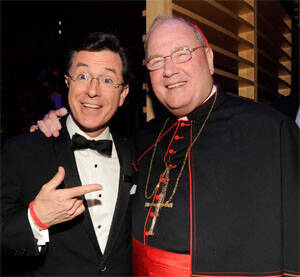Stephen Colbert, who portrays a right-wing blowhard as host of the satirical “Colbert Report” on Comedy Central, is well known for brandishing his Catholic identity. In 2006, in order to disclose his bias toward religion, he recited the entire Nicene Creed on air. In a video on YouTube that has received nearly a quarter million hits, Mr. Colbert does an epic (and hilariously exhausting) liturgical dance to “King of Glory.” On his show he has interviewed prominent Catholics like Garry Wills, Bill Donohue, Simone Campbell, S.S.S., Andrew Sullivan and, of course, America’s own James Martin, S.J., the show’s “official chaplain.”
In Mr. Colbert’s rare moments out of character, however, it is clear that his faith is no joke. A year ago he appeared onstage at Fordham University with Cardinal Timothy M. Dolan of New York and Father Martin for a serious conversation about joy and humor in the spiritual life. At the event, Mr. Colbert said there are flaws in the church but also “great beauty.”
It seemed only a matter of time until Cardinal Dolan would appear on Mr. Colbert’s stage, which finally happened Sept. 3. The host and guest delivered, exchanging quips and generating roars of laughter throughout. There were moments, however, when the conversation went deeper. Cardinal Dolan spoke persuasively about the role of prayer in electing a new pope and the difference between judging people and judging actions. Most notable, perhaps, is where this conversation took place: a venue, outside church walls, where 1.9 million viewers gather each night. At World Youth Day in Rio de Janeiro, Pope Francis implored, “I want the church to be in the streets,” not “closed and turned within.” Mr. Colbert and Cardinal Dolan are helping us meet that challenge.
A Good Idea?
A slogan from the Vietnam War era, “It became necessary to destroy the town to save it,” has come to represent the folly of certain battlefield tactics and even of war itself. What looks like a good idea one day later undermines the war’s long-term strategy.
On Oct. 6, 2010, Lt. Col. David Flynn, convinced that all the villagers of Tarok Kolache, Afghanistan, had left but that the Taliban had seeded the houses and grounds with explosive traps, made the decision to level the village completely with rockets and bombs rather than risk injuring the soldiers who would have to clear the traps. In 2009 Gen. Stanley A. McChrystal told his troops that “destroying a home or property jeopardizes the livelihood of an entire family—and creates more insurgents. We sow the seeds of our own demise.” Nevertheless, the destruction of unoccupied towns and homes was common. The United States promised to rebuild the villagers’ homes and compensate them—at $10,000 each—for their loss.
Kevin Sieff, of The Washington Post, reported (8/26) on his recent visit to the scene—now mostly sand, rocks, ruins of 100-year-old dwellings and empty space. Some U.S.-built concrete buildings in which the former villagers refused to live had already begun to crack. Naiz Mohammad, the district police chief and one of the few to return, said of the residents: “After the bombing, they’ve become pro-Talib. They’re the strongest Taliban supporters in Arghandab.” Colonel Flynn, now in Oklahoma, still thinks what he did was a good idea. Some day, he says, he will revisit the village site and join its residents for tea.
Twitter Trolling
Caroline Criado-Perez, a feminist activist and journalist in the United Kingdom, has recently been making headlines—but not for the reasons she had hoped. Back in July, Criado-Perez successfully campaigned for the inclusion of Jane Austen on the English banknote. The decision, however, has engendered hostile responses from the general public. The journalist has received hundreds of hateful messages, most of them online, since the Bank of England’s decision, including threats of rape and death. She reports that the threats have left her “sick…and horrified.”
Threats like these are part of a larger Internet phenomenon known as “trolling,” in which a person writes an online comment designed to elicit an incendiary response from a targeted person or group. Trolling is one of the many controversial ways to attract attention on Twitter. With its quick, snappy updates and apparent user anonymity, the site too often becomes a way for “trolls” to harass others blatantly, as in Criado-Perez’s case. How does Twitter handle such abuse?
According to Twitter’s rules and regulations, “Users may not make direct, specific threats of violence against others.” Someone who is being harassed can file a report with information like the abuser’s Twitter name, a link and a description of the threat. After the Criado-Perez incident, Twitter released a statement condemning sexual harassment and created a “Report Abuse” button. These, however, are not enough. Offenders should be subject to arrest and punishment, and Twitter must continue to be vigilant, carefully monitoring the effectiveness of these improvements and implementing further safeguards as necessary.








